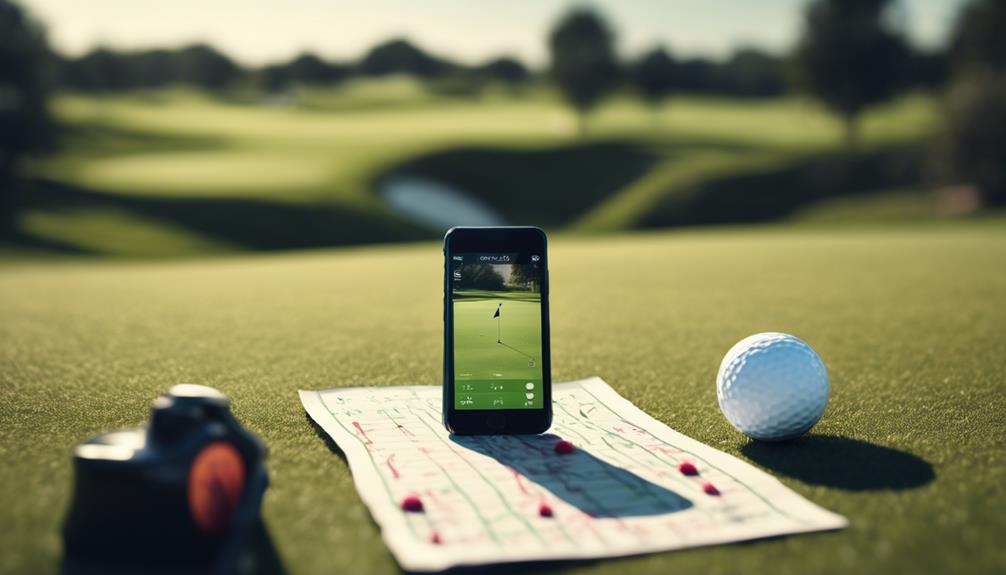- 7 Top Flite Golf Clubs XL for Improved Performance - September 28, 2024
- Top Flite Golf Clubs: Top 5 Reasons to Choose Them - September 28, 2024
- Top 3 Golf Club Fitters for a Perfect Swing - September 28, 2024
You can create a golf club yardage chart in three simple ways. First, track your shots on course by recording every shot, including club used, distance to target, and actual yardage traveled. You can use a notebook, pencil, and GPS device or rangefinder to gather data. Second, incorporate launch monitor data to get precise metrics on ball speed, launch angle, and spin rate. This will help you identify patterns and trends in your swing. Third, work with a golf expert to interpret launch monitor data and create a customized yardage chart. By following these steps, you'll be well on your way to refining your game – and there's more to discover about optimizing your yardage chart.
Key Takeaways
- Record every shot taken, including club used, distance from ball to target, and actual yardage traveled to create an accurate yardage chart.
- Use a launch monitor to gather precise metrics on ball speed, launch angle, spin rate, and carry distance for each club in the bag.
- Collaborate with a golf expert to interpret launch monitor data, identify areas for improvement, and develop a customized practice plan.
- Organize data into different areas, such as driving distances, approach shots, and putting distances, to refine skills and create a tailored yardage chart.
- Transfer data to a distance chart or yardage chart after each round to track progress and make adjustments to optimize the game.
Track Your Shots on Course

As you navigate the golf course, track every shot you take, including the club used, distance from the ball to the target, and the actual yardage the ball travels.
This data will become the foundation of your personalized yardage book, a valuable resource in your pursuit of golf mastery.
Keep a small notebook and pencil in your back pocket to jot down each shot's details.
From the tee box, record the club used and the distance to the target.
After each shot, measure the actual yardage the ball traveled using a GPS device or rangefinder.
Note the carry distances, too, as this information will help you understand your club distances better.
By tracking your shots, you'll start to know how far you hit each club consistently, allowing you to make informed decisions on the course.
After the round, transfer your data to a distance chart or yardage chart, and watch your game improve as you refine your strategy.
Use Launch Monitor Data
Take your yardage chart to the next level by incorporating launch monitor data, which provides precise metrics on ball speed, launch angle, spin rate, and carry distance for each club in your bag. This data will help you understand exactly how far you hit every club, including your Fairway Wood, and make adjustments to optimize your game.
To make the most of launch monitor data, follow these best practices:
- Use the data to create a detailed yardage book that covers every club in your bag, including notes on spin rate and launch angle.
- Analyze the data to identify patterns and trends in your swing, and make adjustments to improve your overall game.
- Compare your data to that of PGA Tour professionals and scratch golfers to see how you stack up and identify areas for improvement.
Work With a Golf Expert

Collaborate with a golf expert who can help you interpret your launch monitor data, identify areas for improvement, and develop a customized practice plan tailored to your unique swing characteristics.
They'll analyze your data to pinpoint patterns and trends, making it easier for you to create an accurate yardage chart. Make sure to ask your golf expert about their experience with creating yardage books, as they can provide valuable insights and guidance throughout the process.
At the pro shop, you can work with a golf expert to customize a Yardage Book Template that's easy to understand and suits your specific needs.
They'll help you organize your data into different areas, such as driving distances, approach shots, and putting distances. Once you have your template, you can print it out at a print shop and start using it every day.
With the guidance of a golf expert, you'll be able to refine your skills and create a yardage chart that's tailored to your unique game. Don't be afraid to ask questions and seek clarification on any aspects you need to know – with their expertise, you'll be well on your way to creating a chart that helps you dominate the course.
Frequently Asked Questions
How Do You Calculate Yardage in Golf?
You calculate yardage in golf by combining golf strategies, course mapping, and swing speed to determine ball flight, considering slope rating, pin position, and fairway width, then fine-tuning with club fitting, distance control, and shot selection.
How to Track Distance in Golf?
You track distance in golf by combining Golf GPS data, Distance Control practices, and analyzing Swing Speed, Ball Flight, and Shot Selection to refine Course Management, incorporating Practice Routines, Fitness Training, and Mental Focus, leveraging Technology Advances for precision.
What Are the Dimensions of a Yardage Book?
As you envision your yardage book, consider the standard 3.5 by 5.5-inch size, but be prepared to adapt to larger formats like 4 by 6 inches or 5 by 7 inches, depending on the course's complexity and your page layout needs.
How Do I Know What Club to Hit?
You'll know what club to hit by considering club selection, swing tempo, ball position, lie angle, and course management, then factoring in pin placement, risk assessment, shot shaping, trajectory control, and body alignment to make an informed decision.
Conclusion
Creating a golf club yardage chart has never been easier!
By tracking your shots on course, using launch monitor data, or working with a golf expert, you can pinpoint your distances with precision.
Now, you're just a few swings away from tapping into your full potential.
Will you be able to shave strokes off your game with your new chart?



